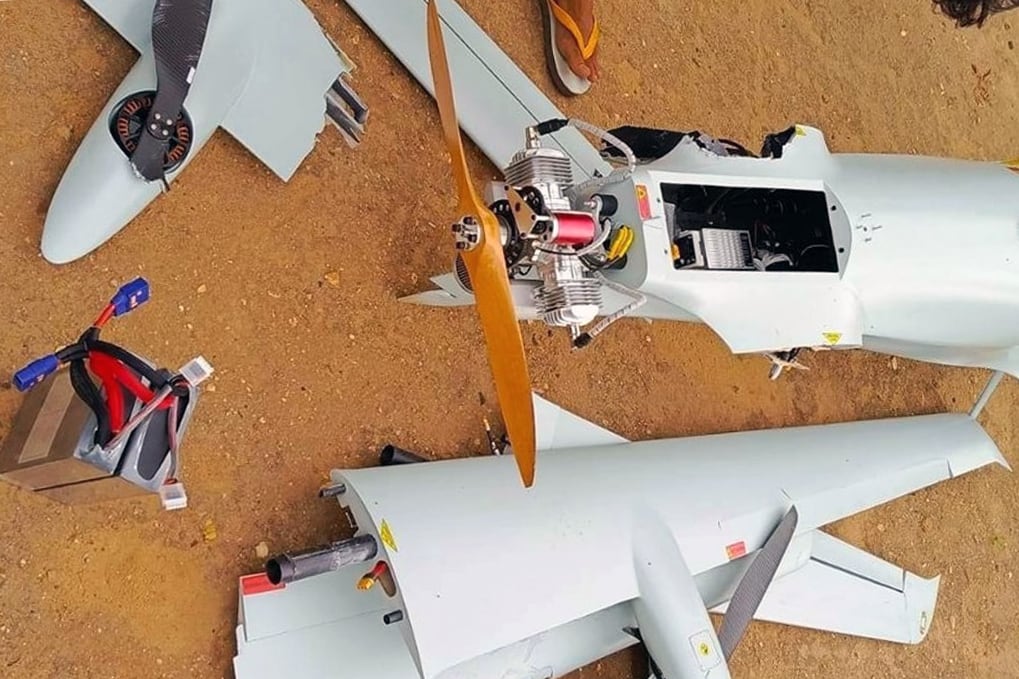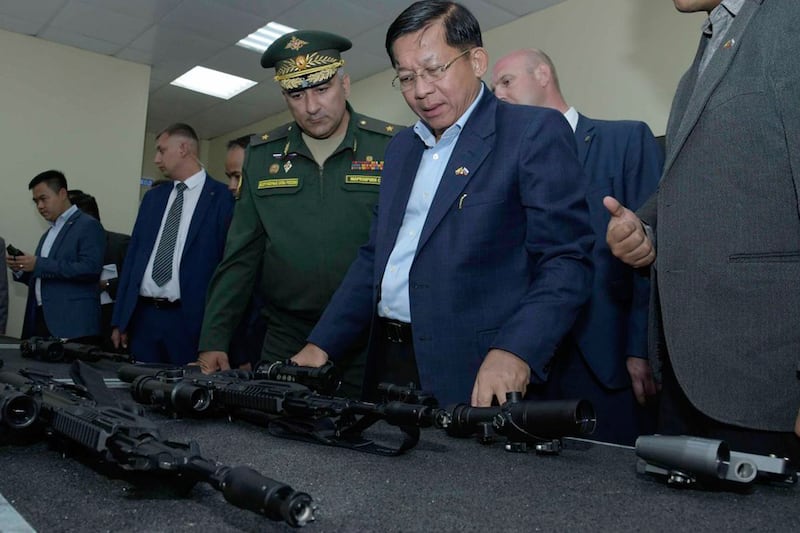The drones from China and Russia are fitted with infrared cameras, allowing them to attack at night.
RFA Burmese – March 15, 2025
Link to the original article.

A Chinese-made high-tech surveillance drone deployed by junta forces was seized by rebel fighters after it crashed in Ayadaw township, Sagaing region, Myanmar, Sept. 4, 2024. (Radio NUG)
Read RFA coverage of this topic in Burmese.
Chinese- and Russian-made drones using night vision cameras are giving Myanmar’s military junta an advantage in its war against rebel groups, according to sources on the ground, touching off what one observer termed a “drone arms race” between the two sides.
The new weaponry is upping the ante in Myanmar, where drones were once solely a tool of the armed opposition seeking a cheap way to level the playing field against a far better-equipped military, which seized control of the country in a 2021 coup d’etat.
Since early February, pro-junta channels on the social media platform Telegram have posted video footage of what appears to be military drone bomb attacks on rebel forces in Kachin state’s Bhamo township using either infrared or thermal night vision cameras and causing casualties.
On Feb. 20, British military intelligence publisher Janes International Defense Review cited the footage in a statement which claimed that Myanmar’s military “has begun enhancing its expanding unmanned aerial vehicle capabilities, adapting forward-looking infrared systems for tactical attack drones.”
Officials from two anti-junta groups — the Kachin Independence Army, or KIA, and a civilian defense unit based in Bhamo — confirmed to RFA Burmese that the military has deployed such drones in combat to devastating effect.
“The junta is using night vision drones in Bhamo battles,” said KIA spokesperson Colonel Naw Bu. “Our officials in the fighting reported that the drones are very advanced, with night vision cameras.”
Naw Bu said he was unaware of night vision drones being used by the military in other parts of the country.
Infrared imaging uses radiation emitted or reflected by objects to create images, while thermal imaging measures heat emitted by objects to create images based on temperature differences. Both provide users with a way to track objects at night.
It was not immediately clear which technology the drones were fitted with. Thermal cameras are a type of infrared camera, but not all infrared cameras produce thermal images.
Drones from China, Russia
Fighting between the junta and the KIA has been intensifying in Bhamo since early January, according to sources in the region.
A member of an anti-junta civilian defense group in Bhamo told RFA that junta forces had been using night vision drones for “about a month” and called their destructive power “considerable.”
“We have [equipment] that can disrupt radio frequencies, and when we hear a drone flying overhead, we have time to defend against it,” said the fighter, who spoke on condition of anonymity due to security concerns. “Nonetheless, on some occasions, we continue to face [drone] attacks with highly explosive bombs, despite our preparations.”
The rebel fighter did not disclose details of casualties caused by these drones, and RFA was unable to independently verify confirm the number of people killed or injured in the attacks.

Some ethnic armed and civil defense groups have claimed that the junta is using drones made in Russia and China — two countries that have backed the military regime since the coup — with a higher reliance on those from China.
Captain Zin Yaw, a former military officer and a member of the Civil Disobedience Movement of public servants who quit their jobs to protest the coup, told RFA that the junta is likely to continue pursuing advanced drones.
“We see that they are actively seeking advanced technology to engage in modern warfare,” he said. “The junta chief [Senior Gen. Min Aung Hlaing] recently visited Russia, and they may have gained a technological advantage from the trip.”
‘Drone arms race’ underway
Attempts by RFA to contact junta spokesperson Maj. Gen. Zaw Min Tun for comment on the military’s use of high-tech drones went unanswered by the time of publishing.
But Thein Tun Oo, the executive director of the Thayninga Institute for Strategic Studies, composed of former military officers, told RFA that he expects the junta will gain a significant advantage with the advanced technology.
“Armed resistance forces should reassess their strategies because their available resources are no match for those of the nation’s military,” he said. “Over time, their resources will dwindle, while the [junta] continues to expand its capabilities.”
Jonah Blank, a senior political scientist at global policy think tank the RAND Corporation, said the military and rebel forces “are now in a drone arms race,” after rebels deployed drones to challenge the junta’s air superiority and the military responded with more advanced drone technology “to try to regain its edge.”
“But these technological advances tend to become cheaper and more easily available very quickly — the rebels will soon have them too,” said Blank, who is also a senior research fellow at the National University of Singapore.
He characterized drones as “inherently democratizing technology,” noting that even the most advanced U.S. and Chinese drones “are far less expensive than these powers’ manned aircraft.”
“This trend inherently favors an irregular army,” he said.
According to data compiled by RFA, junta air and artillery strikes killed at least 1,769 civilians and injured some 3,720 across the country in 2024.
Translated by Aung Naing. Edited by Joshua Lipes and Malcolm Foster.
